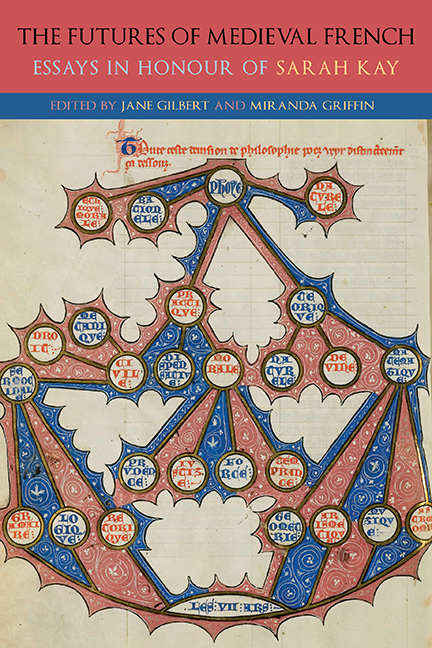Book contents
- Frontmatter
- Dedication
- Contents
- List of Illustrations
- List of Contributors
- List of Abbreviations
- Introduction
- Part I Subjectivity in Troubadour Poetry
- Part II The ‘Chansons de geste’ in the Age of Romance: Political Fictions
- Part III Courtly Contradictions: The Emergence of the Literary Object in the Twelfth Century
- Part IV The Place of Thought: The Complexity of One in French Didactic Literature
- Part V Parrots and Nightingales: Troubadour Quotations and the Development of European Poetry
- Part VI Animal Skins and the Reading Self in Medieval Latin and French Bestiaries
- Afterword
- General Bibliography
- List of Manuscripts
- Bibliography of Work by Sarah Kay
- Index
- Gallica
Places of Thought: Environment, Perception, and Textual Identity in Medieval Vernacular Manuscripts
Published online by Cambridge University Press: 27 May 2021
- Frontmatter
- Dedication
- Contents
- List of Illustrations
- List of Contributors
- List of Abbreviations
- Introduction
- Part I Subjectivity in Troubadour Poetry
- Part II The ‘Chansons de geste’ in the Age of Romance: Political Fictions
- Part III Courtly Contradictions: The Emergence of the Literary Object in the Twelfth Century
- Part IV The Place of Thought: The Complexity of One in French Didactic Literature
- Part V Parrots and Nightingales: Troubadour Quotations and the Development of European Poetry
- Part VI Animal Skins and the Reading Self in Medieval Latin and French Bestiaries
- Afterword
- General Bibliography
- List of Manuscripts
- Bibliography of Work by Sarah Kay
- Index
- Gallica
Summary
HOW ONE ENCOUNTERS medieval vernacular poetry shapes perception of its thought, language modes, images, texts, and textuality. The insights provoked, meanings assigned, and critical methodology deployed correlate with its representational environment. In the case of modern editions, discourse – transposed from a base manuscript into a printed critical text – provides the locus for thought, as for other elements of the works. Texto-centric critical approaches based on such editions have contributed significantly to the vitality of medieval studies in recent decades, not least in debates about the senses, sexuality, gender, corporeality, globality, and race. Among the most prolific and original exponents of such studies, Sarah Kay stands pre-eminent, as colleagues and graduate students on both sides of the Atlantic can attest.
In keeping with Kay's critical spirit in The Place of Thought, as well as with her later work on manuscript materiality (notably in Animal Skins), I want to take here a viewpoint based not on the modern critical edition but on another representational environment: that of the manuscript matrix. A visual and aural environment, the manuscript matrix mixes verbal narrative and graphic image to create a complex representational field appealing to multiple senses: sight, hearing, touch, even smell, since parchment and pigments have distinctive odours. Adding to the complex variables of the folio, each manuscript – even of the ‘same’ work – is a unique event produced by the hands of scribes and artists. In consequence, the manuscript matrix consists of a cognitive field distributed over multiple focal points produced by several agents; namely, the scribe(s) and artist(s) collaborating to offer their version of the poet's work (for which – especially for works prior to the fourteenth century – there is often no original). In other words, the manuscript confronts the reader not with one, but with multiple marks of the mental, each looking at the same object from different intentional stances. While these perspectives differ, they have a common goal: to produce an intelligible and aesthetically pleasing form of the work.
These facts have consequences, and not least for the nature of text and textuality in vernacular literary manuscripts.
- Type
- Chapter
- Information
- The Futures of Medieval FrenchEssays in Honour of Sarah Kay, pp. 185 - 199Publisher: Boydell & BrewerPrint publication year: 2021



